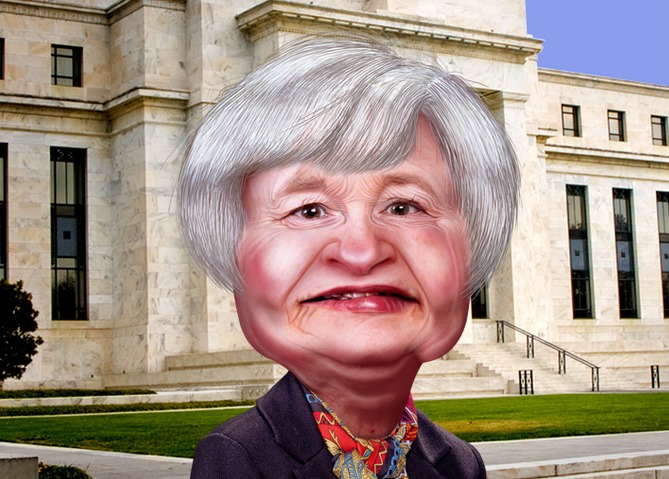It’s been roughly one year since the Fed ended its historic quantitative easing program and gave control of the economy back over to the free market.
With those memories of a Fed-driven market still fresh in investors’ minds, it seems that the Fed is once again in control of this market’s destiny.
Markets are quickly retreating to a “wait and see” trading mentality when it comes to Yellen, which is contributing to a rise in uncertainty and volatility in the broader averages.

Backlash
Investors took the end of QE3 last year as a sign of confidence that the economy was strong enough to stand on its own.
With the decision to hold interest rates steady and not raise them as many had been expecting all year long, the markets have reacted negatively.
Keeping interest rates low means that the economy isn’t as strong as most were expecting it to be by this point and makes fears of a global slowdown much more credible.
US Stocks
Since the end of October last year when the Fed officially turned the reins back over to the markets, stocks have actually underperformed despite initial thoughts of increasing upward momentum.
As of October 5, 2015, the S&P 500 is down 1.54% since the October month end of 2014, while the Dow has shed 3.53%. Contrary to the belief at the time, the economy may not have been quite as strong as investors thought.
House of Yellen
Fast forward from October of 2014 to September of 2015 and the once improving global economy is looking anything but improving.
Oil prices have fallen by nearly 50% over the past year and don’t look to rebound anytime soon. Global energy demand is weak but stable.
Inflation has been one of the biggest problems the Fed has been battling.
Yellen’s language has been indicating that a rate hike won’t happen until inflation picks up and hits the 2% target rate that was previously set. Looking at inflation this year, it’s no surprise why interest rates were held at 0% to 0.25%.
China
The beginning of this year didn’t bode well with deflation actually creeping into the figures but it appears to have picked up some momentum as the year went on.
One thing that stood out during Yellen’s statement regarding interest rates was China. Macroeconomic concerns don’t usually impact the Fed’s direction, but the Fed made it clear that there was cause for worry.
Yellen mentioned “China” and “global” 16 times within one hour, stating that “heightened concerns about growth in China and other emerging market economies have led to notable volatility in financial markets.”
Fed Doves
The dovish views had a negative impact on stocks with the S&P 500 trending lower for the next few trading days as investor sentiment began to crumble.
It was a noticeable change in the Fed’s outlook which up until then had been relatively positive regarding the improvements in the U.S. economy.
However, just a week later Yellen spoke again with a seemingly different message to the markets, stating, “Most of my colleagues and I anticipate that it will likely be appropriate to raise the target range for the federal funds rate sometime this year.”
She reiterated the point that the timing of the first rate hike was more important than the actual hike itself as the gradual rise would need to be carefully managed to keep the economy on track.
Confidence Grows
After the second speech, the markets appeared to gain some confidence with the S&P 500 gaining ground over the past week.
The idea of rates still being raised possibly in December helped investor sentiment regarding the economy with Yellen putting a larger focus on returning to full employment along with a rise in inflation.
It made sense that the markets dipped following the disappointing announcement that the Fed would not be raising interest rates as previously expected.
Fickle Investors
The news was taken as a clear signal that the Fed did not have enough faith in the economy’s strength to go ahead with the hike.
And later with Yellen’s second, more hawkish speech indicating that a rate increase for 2015 was still on the table, the markets reacted more favorably. But as Wall Street goes, the mood is very fickle.
Employment figures have been one of the key indicators of economic strength and one of the items that the Fed is taking into consideration regarding a rate hike movement.
Jobs Data
The unemployment is currently 5.0% as of October. However, the average number of jobs added by the economy over the last three months is 167,000 a month compared to an average of 260,000 per month over the previous twelve months.
The participating rate dropped as well from 62.6% to 62.4%, an indication that there has been an increase in discouraged workers – those who have dropped out of the workforce and aren’t looking to be employed.
The report should have been seen as a negative for stocks and a blow to the Fed’s earlier statement that rates could increase later this year, but the markets seemed to take it as a positive sign.
Oil Prices
It’s a reversal of mentality that means investors are more enticed by the prospect of continued low interest rates and less concerned about the larger issue of macroeconomic strength.
While an increase in oil prices has helped turn stocks around in recent weeks, the message is still clear: investors are more interested in short term events and less concerned about the larger economic issues right now.
Mood Swings
As investors fluctuate between a positive mentality regarding extended low interest rates and a negative one when considering what that means about the economy as a whole, the impact of a rate increase is now more unclear than before.
We need to first take a look at why the Fed decided to hold off the rate increase in the first place.
Considering the mixed economic data, the Fed didn’t feel confident enough to raise rates and put pressure on the economy.
While the unemployment figure is very close to signaling full employment for the U.S. economy, new job additions and inflation remains low.
Normalizing Rates
Raising or lowering rates is about balancing growth and inflation for the Fed.
An increase too soon will cut the legs out from under an economy struggling to grow, but delaying a hike too long could result in rapid inflation in my opinion.
It’s been over six and a half years since the Fed put the benchmark rate near zero and around nine years since the Fed last raised rates.
The idea is to let the economy get healthy enough for borrowing costs to balance out with a rise in inflation.
What Next
Looking forward, there are two possible dates in the near future that rates could finally go up.
The Fed meets on December 16th of this year and then again on March 16th, 2016.
But macroeconomic events like the Chinese stock market crash, the collapse of oil prices, and a general malaise in the global economy have weighed heavily on the Fed’s decision making process.
It’s not just the action of a rate hike that will impact markets, but the mood set forth by the Fed itself.
An example of this happened after Yellen announced that rates would hold steady and the market fell only to recover a week later after she made comments that a rate hike could still happen this year.
Conflicting Signals
If investors are uncertain about the rate increase, it isn’t being helped along by Fed committee members.
There’s some disagreement about the direction of the economy and the timing of a hike, which is making it difficult to anticipate the Fed’s next move.
Arguments on both sides make a case for and against a rate hike this year citing macroeconomic influences, inflation numbers and jobs data.
Furthermore, if global and domestic economic data don’t improve and continue to deteriorate, we may not even see a rate hike in 2016.
Slow Walk
Regardless of the actual timeline of the first rate increase, Yellen has made it clear that the intention is to raise it by 1% per year at a gradual pace.
Unless inflation picks up significantly by December, it seems unlikely that the Fed will raise rates this year. The recent employment numbers are just another thorn in the side of the argument that a rate increase is imminent.
We need to see some improvements in the economy before the Fed will feel comfortable raising rates but a delay in the hike isn’t all bad news for the stock market.
I believe that companies now see how close a hike actually is and could start borrowing as much as possible now while rates are still low which could give the market a boost in the fourth quarter.
Photo Credit: DonkeyHotey via Flickr Creative Commons


